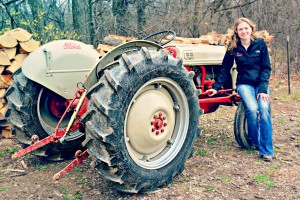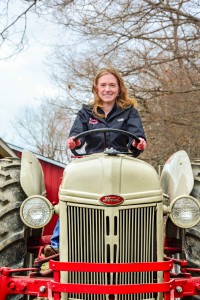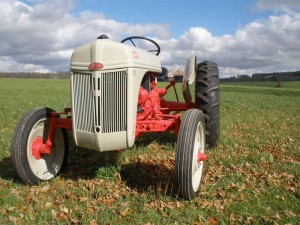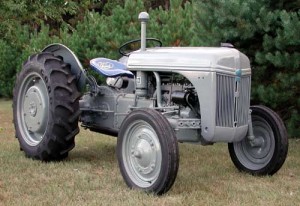Jay Unger, owner of Twin Valley Equipment in Eaton Ohio, restored this Ford 8N with the help of Craig Roberts. Many parts from Steiner Tractor Parts were used.
Great job guys!
Tractor Restoration | Tractor Clubs | Tractor Shows |Tractor Repair | Repair Videos
by ST 3 Comments
by RG 15 Comments
Here are the Top 8 Reasons why I love the Ford 8N:

 How about you – are you a fellow 8N lover? What makes you a fan?
How about you – are you a fellow 8N lover? What makes you a fan?
by RG 67 Comments
One of the most popular tractors of all time, the Ford N-series tractor is an American icon. More than fifty years after the last 8N rolled off the assembly line, these tractors are still incredibly popular. You’ll see them all over – at auction sales and dealerships, but also alongside the road with a “For Sale” sign, at garage sales, and even at your favorite restaurant on date night (true story – as often as we’ve had to go home to get a trailer, we should really learn not to leave home without them!).

As beloved as factory original N-series tractors are, I’ve seen plenty that are rather… unique. Like the one I bought from an old hippie that was painted bright yellow, with flowers all over the hood. I thought I’d have to repaint it, but before I got around to doing so it was spotted by another customer who just LOVED the paint job. Problem solved, no paint required!
For a more serious collector, though, being able to identify exactly which of the N-style tractors (9N, 2N, or 8N) you’re looking at is very important. While we’ve gone into specific details about the year-to-year improvements in N-series tractors before (click here), today I’m going to give you a quick “field guide” to determining the model of an N-series tractor.

First, a quick history lesson: the 9N was introduced in 1939. It was followed by the 2N in 1942, and early models were greatly impacted by wartime rationing. Once the war was over, a new and much improved 8N was introduced in 1948.
As my hippie tractor will demonstrate, paint color can’t always be counted on. But since it is the first and most obvious clue available, you should know that 9N and 2N tractors were painted all grey, while a red and grey paint job was for 8N tractors. Plenty of people are unaware of this, though, and will paint their 9N or 2N red and grey as well. So don’t trust the paint job too much.
9Ns and 2Ns are rather similar, but there are some big differences between them and the 8N. So it’s easiest to see if you have an 8N first, and save the smaller 9N v. 2N differences for later.
You are definitely looking at an 8N tractor if:
Of course, the 8N had plenty of other improvements over the 9N and the 2N – but these features are the easiest to spot and the hardest to modify.
If the tractor definitely isn’t an 8N, then you’ll need to examine more closely the differences between a 9N and a 2N. This can be hard to do, because the transition between the 9N and the 2N wasn’t as clean-cut as the transition to the 8N later on. Wartime rationing and a desire to reduce waste lead to a slower switch, as features were modified once the previous model’s parts were used up.
That being said, here are some clues that can help in most cases:
The dividing line is a little soft between a 9N and a 2N tractor. If these tips don’t give you a conclusive answer and the serial number isn’t readable, this article might help you figure out exactly what your tractor is.
But sometimes, you might have to settle for a 19N (9+2+8) – that’s what my family jokingly calls an N-series tractor that, over the years, has gained features from each model rather than staying true to it’s specific characteristics. The beauty of N-series tractors is that they are very common and very similar – this yields a steady stream of aftermarket modifications and parts swapping from one model to the next. While these happy hybrids with mixed parts and unreadable serial numbers might make purists cringe, I think Henry Ford would be happy to see his legacy of ingenuity and tinkering live on.